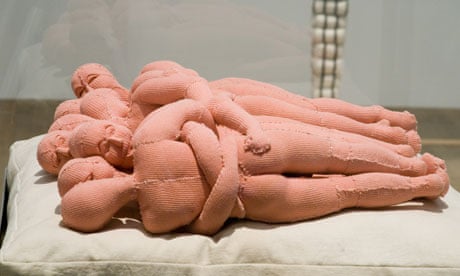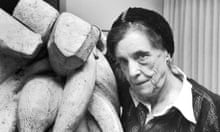The art of Louise Bourgeois puts the feeble one-hit wonders, the diamond skulls, the next-big-thing careerist chancers and the defenders of this or that latest tendency in their place. Her work sees off all the dumb arguments about whether contemporary art is worth looking at, or whether it is about anything. Her art is full of content and meaning. It demonstrates all kinds of skills and inventiveness. Her art is full of variety and it is utterly consistent.
Bourgeois's work refutes all the complaints people make about recent art. Her art is poetic at a time when the word has become debased. She could carve a pair of marble hands or make a little figure from the most wretched and raddled scraps of old cloth. She happily used ready-made objects – mirrors, laboratory glassware, old clothes, bits of machinery. Her art is about jealousy and sex and the things that make life worth living and, at times, make it unbearable. Her art is full of subversive humour, dangers and fears. And there was something about this little old French lady living in New York that was as tender and ferocious, as indomitable and as canny, as the things she made.
Bourgeois was a wise old bird, and she had a dirty mind, as her work demonstrated over and over again, since she began in the 1930s. She had strong opinions and was as likely to form her views from the most laughable self-help books as from great literature. In her long life, she met just about every artist worth mentioning. She knew Vuillard, Bonnard, Matisse, Léger (who told her to stop painting and start sculpting), Duchamp and Miró, Brancusi and Giacometti, as well as all the younger artists who came to her regular, argumentative Sunday salons. As a rule, she said, she reacted against them all, which for Bourgeois meant going her own way.
At a big group show some years ago, looking at a sculpture of a naked, headless woman whose body arched off the flat bed of a huge old band-saw, dangerously close to a fearsome rusty blade, an American standing next to me announced, loudly: "Louise Bourgeois never liked her father, overly. Nor he her." He was really only repeating a part of the artist's own self-perpetuated legend, a story she told to herself and her art told the world. "Everything I do is inspired by my early life," Bourgeois wrote in the 1980s, and what inspired her most was her father's affair with little Louise's English tutor, Sadie, whose neck, the artist said, many years later, she would like to wring.
That Bourgeois's art was an unending exorcism is not in doubt. Her 2007 Tate retrospective opened with a model of her parents' chateau, over which hung the blade of a large guillotine. Writing on Freud, she said the psychoanalyst "did nothing for artists, or for the artist's problem, the artist's torment". Artists repeat themselves, she observed, "because they have no access to a cure". To be born an artist was both a privilege and a curse.
A writhing nest of penises
In her art, women became houses, mothers became spiders, and spiders hung around "the doorways of the years" like prostitutes. In one sculpture, she portrayed her husband, the art historian Robert Goldwater, as a vulnerable, almost feminine head emerging from a writhing nest of flopping penises – she wanted to make him sexy, she said; and she also produced a costume bulging with rows of breasts, to be worn by a man. We are all vulnerable, and all male-female, she said. So there she is in the famous 1982 Robert Mapplethorpe photograph, grinning mischievously and carrying a huge latex sculpture of a cock and balls. There were penises and vulvas and eyes, mangled rabbit sinews, things that look like cowpats and things that look like sex toys. Her art was one of transformations, of ferocious vulnerability and tender violence.
As well as objects, her environments, which she called Cells, were also containers of feelings, of atmospheres that could smother you or cut like a knife. Her most popular works were probably her big spiders, but they were not her best work. The thing about Bourgeois was that she was free to make what she pleased, good and bad alike. But she was never mediocre.
Bourgeois's lesson is not to do with her style or manner as an artist, nor even her longevity, though she had to wait till she was in late middle-age to get the wider recognition she deserved. Other artists have had to wait as long. Nor was it a case of late flowering, because Bourgeois's art has been consistent, whatever its materials, and whether in sculpture, installation, in drawing and printmaking and writing. Bourgeois was more interested in life than in having a career, except that for her, life mostly meant being an artist and making work, and nursing her childhood grievances, which fuelled all her art. "You gotta watch that woman," Bruce Nauman once said of her. And still we must.
'I am still a girl trying to understand myself': Louise Bourgeois in her own words
On drawing
"I have drawn my whole life. My parents were in the tapestry restoration business, and as a young girl, I would draw in the missing parts of the tapestry that needed to be re-woven. My ability to draw made me indispensable to my parents."
On sculpture
"At the dinner table when I was very little, I would hear people bickering – the father saying something, the mother choosing to defend herself. To escape the bickering, I started modelling the soft bread with my fingers. With the dough of the French bread – sometimes it was still warm – I would make little figures. And I would line them up on the table and this was really my first sculpture."
On the art world
"Women had to work like slaves in the art world, but a lot of men got to the top through their charm. And it hurt them. To be young and pretty didn't help a woman in the art world, because the social scene, and the buying scene, was in the hands of women – women who had money. They wanted male artists who would come alone and be their charming guests. Rothko could be very charming. It was a court. And the artist buffoons came to the court to entertain, to charm. Now it has changed, now the younger men are in – older women and younger men."
On England
"England is very, very important to me, because in my family the English could do no wrong. When my father picked a mistress, it was always an English girl: if he made her pregnant, she could be shipped back to England and he would not be held responsible. It never happened, but I've made a lot of work called The English Can Do No Wrong."
On critics
"I do not need the musing of the philosophers to tell me what I am doing. It would be more interesting to let me know why I am doing it."
On feminism
"The feminists took me as a role model, as a mother. It bothers me. I am not interested in being a mother. I am still a girl trying to understand myself."
On modern art
"What modern art means is that you have to keep finding new ways to express yourself, to express the problems, that there are no settled ways, no fixed approach. This is a painful situation, and modern art is about this painful situation of having no absolutely definite way of expressing yourself."
On spiders
"I came from a family of repairers. The spider is a repairer. If you bash into the web of a spider, she doesn't get mad. She weaves and repairs it."





